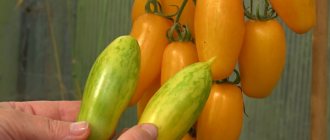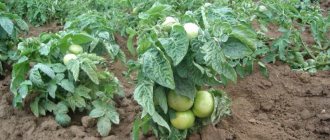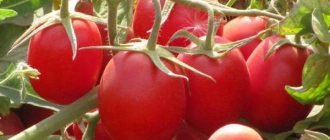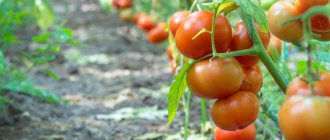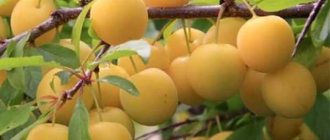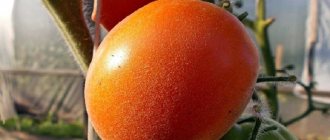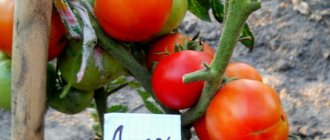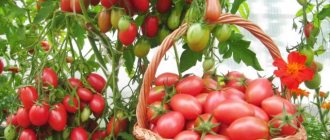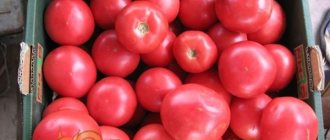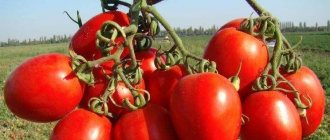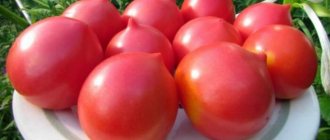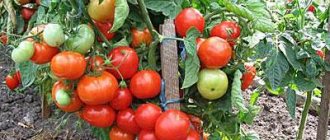Useful tips for gardeners
Tomatoes do not need high air humidity during fruiting, so the greenhouse must be ventilated in any weather, even cloudy. Optimal conditions for tomatoes:
- soil moisture 70-80%;
- air humidity 60%.
If soil moisture changes frequently, the growth of the root system stops, the plant does not receive enough nutrients, and this reduces immunity. Tomatoes are suffering from infection. Due to sudden changes in soil moisture, buds and ovaries fall off, and fruits crack.
It’s not difficult to avoid the problems listed above; it’s enough to properly organize the watering of tomatoes:
- to prevent the seedlings from stretching out, they are not watered for 7 days after transplanting to a permanent place;
- a week after transplanting, they begin to water abundantly and often;
- When the first ovaries appear, the tomatoes are watered 2-3 times a week.
Water is poured at the root, watered early in the morning before the heat sets in. The greenhouse is ventilated so that condensation does not form on the ceiling and walls. Pathogens of tomato diseases can be contained in drops of moisture. Falling on tomato leaves, they can provoke an outbreak of fungal disease.
It is possible to grow a good crop of tomatoes without mineral fertilizers if the soil is fertile. You can’t do without them if she’s exhausted. Tomatoes begin to be fed 10 days after transplantation. The signal for feeding is pale leaves, thin stems. Feeding recipe:
- water 5 buckets;
- slurry 1 bucket;
- superphosphate 20 g;
- ash 30 g.
Solution consumption for 1 tomato bush is 0.5 l. The following feedings are carried out every 2 weeks, organic ones alternate with mineral ones. Recipe for fruiting tomatoes:
- pour 2 liters of ash into a bucket;
- pour boiling water;
- insist;
- strain;
- increase the volume to 10 l;
- pour in 1 bottle of iodine;
- Dilute 15 g of boric acid in warm water, pour into a bucket, mix everything.
Before watering, dilute the resulting concentrate with water in a ratio of 1:10. Pour 1 liter of fertilizer under each tomato bush.
The varieties are not heat-resistant; it makes no sense to grow them in the south. The harvest will be minimal. When the air temperature rises above 32 °C, pollination will not occur and the ovaries will fall off. In order not to waste your time and energy, you need to buy tomato varieties recommended for cultivation in the North Caucasus region.
Growing
Volgograd tomatoes are grown both in greenhouses and in open ground. Typically, such tomatoes are planted using the seedling method. In order to grow a good harvest, it is necessary to prepare a bed in advance, which is done in late autumn. The soil is dug up and fertilizer is added in the form of humus and minerals.
Ammonium nitrate is the best fertilizer for most cultivated plants
Before planting seeds for seedlings, they are soaked for two hours in a weak solution of potassium permanganate, and then washed with water. For sowing, take specially prepared soil, which can be purchased in specialized stores.
Wooden boxes are used for sowing seeds. The sowing depth should not be more than 2 cm, otherwise the sprouts will not be able to hatch. The distance between the seeds is 3 cm. Water the plantings with warm water and cover with film. The boxes are put in a dark and warm place. As soon as the shoots appear, and this happens after about a week, the film is removed and the containers with seedlings are placed in a bright place. If the weather is cloudy, seedlings will need artificial lighting.
After 5-7 strong leaves appear, the seedlings must be planted in separate pots.
Seeds are sown for seedlings, usually in March - April, depending on where the plants will be planted - in a greenhouse or open ground. The sowing time is chosen in accordance with the lunar sowing calendar for tomatoes.
In the open ground
Seedlings are planted in open ground 30-45 days after sprouts appear, as soon as the threat of night frosts has passed. Usually this happens in early June. In order for the plants to take root as much as possible, they are taken out into the open air in advance, every day increasing the duration of their stay on the street.
Seedlings begin to be grown at home in early spring
Seedlings are planted on the beds according to the 50x70 pattern, adding nitrogen-containing fertilizer to the prepared holes, as well as a handful of wood ash, which will protect them from rotting and saturate the soil with minerals.
It is recommended to mulch the soil around the roots of tomato bushes with sawdust to make them easier to care for.
Water the plants abundantly, once every 10 days, early in the morning or after sunset to prevent sunburn.
Care also includes planting tomatoes and feeding them. If a small number of ovaries form on the plants, they should be fed with urea. Also, to achieve high yields, organic fertilizers should be applied - last year's manure and compost.
The stepsons are removed early in the morning, leaving small shoots so that the branch does not grow again.
In greenhouses
Seedlings are planted in greenhouses according to the same scheme as in open ground, but a little earlier - in May. The principle of planting and care is the same. The only thing you need to do is open the greenhouse in hot weather so that the plants do not cook from the heat. Growing tomato seedlings at home is described in this material.
It is very important to ventilate the greenhouse, but you need to take into account that tomatoes do not like drafts
This is also done in order to provide access to tomato bushes for pollinating insects when the plants begin to bloom. Read more about
Watering under film cover is carried out somewhat more often - once every seven days.
Pros and cons of the variety
Advantages
- Early variety. Summer residents can try tomatoes already at the end of June, beginning of July. The Volgograd pink tomato variety has a similar ripening period;
- The fruits are neat, even, compact, and of the same size. Average weight – 70 grams. Another variety of Volgograd selection, bred in 1989, has similar tomatoes - Volgogradets. The description of the Volgogradets tomato contains characteristics similar to Volgograd. For example, they are similar in terms of ripening, fruit color (scarlet color with an orange tint), determinate bushes, etc.;
- Tomato Volgogradsky 323, like Watercolor, Asvon, Parodist, does not need to be tied to a support or pinned. The plant is not tall - about 25-45 cm;
- Decent yield. 5-7 kg of tomatoes are removed from the bush. Another low-growing variety that has similar yields is Alaska;
- Excellent transportability. Like the varieties Diana F1, Kubanochka F1, Belfast, Volgograd tomatoes can be transported over long distances by placing them in boxes in several layers;
- Undemanding to watering. You need to water no more than once every 14 days. The varieties Gina and Kaspar F1 have similar characteristics;
- The fruits ripen together. In this, Volgogradsky is similar to the Raisin tomato;
- Resistant to common diseases: tobacco mosaic, fusarium, verticillium, brown spot. Volgogradets tomatoes and the Volzhsky variety have the same advantage.
Flaws
- Like the Dachnik variety, the Volgograd tomato bears fruit for a short time. Approximately all the fruits can be collected in a few weeks;
- Labor-intensive harvesting. Compact tomatoes are more difficult and take longer to harvest than large ones.
Volgograd early ripening tomato 323 is easy to grow. The variety is suitable for beginner gardeners. Caring for it is simple. It is recommended to water it infrequently; there is no need to tie it up or stake it. At the same time, tasty fruits will ripen in the first half of summer. Tomatoes are suitable for fresh consumption and storage for the winter.
Tomato Volgograd early ripening pot
One of the most popular varieties of early ripening tomato varieties are the non-hybrid varieties Volgogradsky 323 and 5/95. Variety 323 was bred back in 1973, and variety 5/95 was bred 20 years earlier in 1953.
Description of the variety
Early ripening variety. The bush reaches a height of 45-80 cm , with a large number of leaves and branches, with a peduncle above each leaf or after 2, depending on the species. Surprisingly, the fruits grow the same size: smooth, round-flat. The color of the fruit is red-orange or pink.
Tomato variety Volgograd
The Volgograd variety is sweet, fleshy, and transports well. The plant is unpretentious and can be cultivated. Any beginning gardener, if he follows the instructions for care and cultivation, will be able to grow a rich harvest.
The ripening period of a tomato ranges from 100 to 130 days . The fruits, depending on the chosen type, can weigh from 70 to 150 grams.
Productivity reaches from 1 square meter from 4 to 7 kg. The plant is resistant to diseases and tolerates temperature changes. Valued for its stable harvest.
Volgogradets is universal in use. It can be canned, eaten fresh, or used to make pastes, purees, and juices.
a brief description of
- the variety is divided into early ripening and late ripening ;
- has immunity to certain diseases;
- tolerates drought ;
- gives a rich harvest ;
- has a long shelf life ;
- can be transported ;
- fruit with juicy pulp.
What is the difference between types 323 and 5/95
Summer residents still prefer old tomato varieties, although more and more improved, hybrid varieties are appearing. The Volgograd tomato has 2 types: 323 and 5/95 . The difference between these varieties is in the timing of ripening, color and weight of the fruit.
Grade 5/95
Late tomato variety Volgogradsky 5/95
It is late, since 120-130 days pass after the seeds grow . When tomatoes are fully ripe, they become deep red in color and greenish-yellow at the base. The average fruit weight is from 100 to 150 grams. The tomatoes are even, smooth, with juicy pulp. The height of the plant reaches 80 cm. The harvest is formed at a height of 6 leaves and continues every 3 internodes. There are about 6 inflorescences in the plant's racemes. Tomatoes 5/95 are suitable for consumption in any form.
Grade 323
Early ripening tomato variety Volgogradsky 323
It is early ripening and can be consumed after 100-110 days. The first harvest appears after 90 days , so at the end of June you can already taste delicious tomatoes straight from your garden.
The color of the tomato is red with an orange tint. Weight on average 70-80 g. Although the size of the fruit is small, up to 10 tomatoes grow on one bush. This abundance of fruiting occurs due to the formation of nodes under each leaf, starting from the fifth. Unlike variety 5/95, 323 has a low bush up to 45 cm .
Is it true that varieties are suitable only for the Volgograd region
There are rumors that the Volgograd tomato is only suitable for growing in the Volgograd region. But this is a mistaken opinion.
Tomato is recommended for cultivation in the southern regions, because the highest yield is noted there.
Ideal for Astrakhan, Volgograd, Belgorod, Crimean region, Kuban. In the middle region of Russia you need to cover the tomato with film . In the northern zone, this tomato can only be grown in greenhouses, otherwise taste and yield will suffer.
Black varieties
Did you know that black tomatoes appeared in the middle of the last century? They were obtained by crossing red fruits with wild ones.
These types are considered more beneficial than regular red tomatoes, as they have antioxidant properties. You can consider the following options:
- Black Moor is a mid-season tomato. The bush yields about 4-6 kg of tomatoes. The vegetable is good fresh or as an ingredient for preservation.
- Mid-season varieties include De Barao. The height of the stem can be up to one and a half meters. The plant requires staking. The shape of the vegetable is elongated. This is a disease-resistant variety.
- Chernomor belongs to the mid-early category. Gardeners remove up to 3.5 kg from a bush. Delicious vegetables are obtained in 120 days. The color of the tomatoes is brown-red. The fruits are of medium size.
- Negrotok is capable of producing up to four kg per bush. The fruits have black skin and reddish uniform pulp. These are sweet tomatoes used for salads.
Reviews and recommendations from summer residents
Experienced gardeners and vegetable growers who grow tomatoes for their own home use and sale speak positively about the highly productive and very unpretentious varieties “Volgogradsky-323”, “Volgogradsky-5/95” and “Volgogradsky pink”.
All of the listed varieties are very responsive to fertilizing and relatively abundant watering, especially at the stage of fruit formation and ripening of the crop. According to the observations of domestic summer residents, it is necessary to regularly remove stepsons that form in small quantities on determinate plants, which allows for maximum yield.
Harvest and storage
Harvesting begins when the fruits have acquired the characteristic color of the variety and are ripe. Vegetables can be picked from the bush even slightly unripe: they ripen perfectly on their own, while the taste does not change at all. It is recommended to collect tomatoes before the cool of the evening or early in the morning to avoid dew. It is worth picking them with the stalk, since if it is present, the fruits are stored better. If the weather is dry or excessively hot, the “Volgograd” variety does not pigment the fruits actively enough, so it takes longer for them to turn red. You can remove the tomatoes from the branch, but it would be wise to wait a few days for the tomato to ripen and be saturated with plenty of vitamins.
Picked tomatoes are stored in wooden or plastic containers, in which the vegetables are placed in rows with the stalk facing up. The maximum number of rows is 3. The storage room should be cool and dark (refrigerator, cellar, basement). Comfortable storage temperature is +5–12 °C at a relative air humidity of 80%.
For storage, fruits with whole skin and no damage are sorted. Tomatoes that have reached milky maturity (turned brown) and have acquired the size characteristic of the variety are perfect. You should periodically check containers and discard vegetables that begin to spoil.
Features of the climate of the region
In most southern regions the climate is temperate continental. Winters are mild, summers are hot and dry, spring is warm and rainy. The seasons change smoothly; the frost-free period in the south is long. In the Krasnodar Territory, winter begins in December, so in the open ground the last tomatoes are harvested in October, in greenhouses - before the New Year.
| Region | Times of Day | April | May | June | July | August |
| Krasnodar region | Day | 13-15 °C | 20°C | 25 °C | 28-30 °C | 29-32 °C |
| Night | 6-9 °C | 10-15 °C | 18-20 °C | 18-23 °C | 19-24 °C | |
| Stavropol region | Day | 14 °C | 20°C | 24.4 °C | 27.5 °C | 28°C |
| Night | 6 °C | 8-13 °C | 16.4 °C | 18.8 °C | 19 °C | |
| Volgograd region | Day | 13°C | 25 °C | 28-29 °C | 31-32 °C | 31°C |
| Night | 6 °C | 16 °C | 18°C | 21°C | 22°C | |
| Astrakhan region | Day | 17 °C | 26 °C | 30°C | 33°C | 33°C |
| Night | 8°C | 17 °C | 22°C | 23°C | 22°C | |
| Rostov region | Day | 14 °C | 25 °C | 26 °C | 29°C | 31-32 °C |
| Night | 6 °C | 13°C | 16 °C | 19-20 °C | 10-15 °C | |
| Crimea | Day | 13°C | 20°C | 25 °C | 28°C | 28-29 °C |
| Night | 10°C | 16 °C | 21°C | 24°C | 25 °C |
READ MORE: Turkish carnation flower photo, cultivation, care and 3 methods of propagation
It is important to know!
Tomato pollen becomes sterile when the air temperature is above 35 °C. Some flowers are not pollinated, dry out, and fall off.
Gardeners in the Krasnodar Territory begin the planting season in February; after May 20, they harvest ground tomatoes. Warm summer weather creates ideal conditions for growing tomatoes, but heat and drought require special agricultural technology and the planting of heat-resistant varieties, hybrids resistant to fungal diseases, and blossom end rot.
Despite this, summer residents are not averse to experimenting and planting some new thing in their beds that deserves attention. The Volgograd tomato variety is just that. For some, it has already been tried and loved, while others have never heard of it.
This article will introduce readers to the characteristics and features of the variety, and how to grow it to get a decent harvest.
Characteristics and features of the variety
Frost resistance
Tomato Volgogradsky characteristics and description of the variety should begin with its frost resistance. The vegetable can be planted both in open and protected ground, but it does not tolerate spring frosts. The plant stops developing at +7…0 degrees. Summer cooling (up to +13…+17) does not frighten Volgograd growing in the open air. She can easily stand it. The same applies to heat.
Easily tolerates lack of rain and watering.
Cultivation of the crop takes place through seedlings that are grown at home. The variety can be planted with seeds in heated greenhouses (where at least +16 degrees) on high beds. Due to the fact that the variety is early, the seeds can be planted in open ground or a regular greenhouse at the end of May. The main thing is that the air temperature is not lower than +18…+22 degrees.
Productivity
Volgograd tomatoes 323 need 3.5 months to produce a harvest. This is an early variety. It takes about 100-108 days from full germination to the first ripe fruit. Approximately tomatoes can be served at the end of June, beginning of July. The variety is suitable for gardeners who do not want to wait long. According to reviews, the bushes do not bear fruit for a long time - about 15-25 days. In order to have fresh tomatoes before autumn, it is recommended to grow additional varieties of crops on the plot.
The yield is decent. The Volgograd tomato produces 5-7 kg of tomatoes per bush.
Bloom
The variety is early, so flowering occurs 20-25 days after planting in a permanent place or 80-85 after sowing seedlings. Lasts about 4-6 days.
The peculiarity of the variety is the huge number of yellow flowers. Flowering is going on smoothly. A peduncle is formed under almost every second leaf.
The best pollinators are bees. If the plant is in a greenhouse, then during flowering you need to open windows and doors. You can lure bees with sweet jam left in a cup near the door in the building. It is allowed to pollinate the bushes yourself. To do this, branches with flowers are gently shaken in the morning. You can use a thin stick to pry up the branches. This way the pollen will get to the pistil faster. After such manipulations, you can spray the flower stalks with water using a sprayer. This is done to secure pollination.
Plant parameters
The advantage of the plant is its compact size. The bushes are not large. There is no need to tie them to the support. The height of one plant is about 25-45 cm. It is determinate. Chunky. The stems are powerful. There are a lot of branches and leaves, but pinching is not required. The tomato itself regulates the formation of branches. They are not thickened. Air circulation between branches is excellent. Medium sized leaves. Their color is green. There are wrinkles.
The stems and leaves have stiff hairs. Hairiness is a distinctive feature of the variety. Summer residents also love these tomatoes because they can grow well both in the garden and in the apartment, on the windowsill.
The fruit is well formed
The inflorescences are simple. Each one produces 5 to 10 fruits. The first inflorescence can be seen above the 7th leaf. Each next one grows through one or two leaves.
The root system is developed and grows very wide. Because of this, it is recommended to plant bushes at a distance from each other - approximately at a distance of 60-70 cm.
Description of fruits
- A pleasant feature of the variety is that almost all fruits growing on one branch are the same size;
- The shape of the tomato is round, sometimes flat-round;
- The tomato is even, smooth, without dents. Rarely, ribbed specimens are found;
- Average weight – 74 grams. The lower tomatoes are larger than the upper ones. The lower ones can reach a mass of 80-95 grams;
- The skin is thin and durable. The fruits are not afraid of transportation. They can be placed in several layers in boxes. Because of this, the Volgogradsky 323 tomato is valued by businessmen. It is often grown for sale;
- The color of the peel is rich scarlet. There is an orange tint;
- The taste characteristics are decent. The fruits are aromatic, moderately sweet, and have a piquant sourness. The dry matter in the pulp is 6%, sugar – 3%. Suitable for fresh salads, snacks;
- Due to the compact size of the fruit, the variety is in demand among housewives engaged in canning. Tomatoes fit entirely into jars without any problems. They do not crack when poured with hot water. The rich taste of the Volgograd tomato allows you to make tomato sauce, tomato caviar, and adjika from it.
Note! Tomatoes have beneficial properties. They eliminate problems with the digestive tract, reduce the risk of cancer, have a positive effect on the skin, and increase immunity
For example, if you drink a glass of fresh tomato juice with a spoon of honey every day, you can improve your health and strengthen your immune system.
Best Type of Tomato for Region
The Volgograd variety is best suited for the conditions of the region. The bushes of the plant are low (from 0.2 to 1.0 m). The weight of the fruit reaches 80-150 g. The plant is resistant to some diseases, for example, fusarium. The fruits retain their attractive appearance during long-term transportation.
There are 3 types of these tomatoes:
- The Volgograd pink variety ripens in 95-110 days. Has a powerful root system. This is an early ripening type, its fruits weigh up to 0.13 kg. They are pink in color and their shape is close to a sphere. The plant withstands sudden drops in temperature well.
- The early variety Volgogradsky-323 ripens within 100-105 days. The maximum height of the bushes is about 0.4 m. The fruits have slight ribbing. They are colored red, and their weight ranges from 80 to 100 g. The yield is average, but the plant is well resistant to diseases such as fusarium and verticillium.
- Volgogradsky 5/95 bushes produce a harvest in 120 days. The plant's height does not exceed 100 cm. The fruits are red, weighing up to 150 g. They can withstand long-term transportation.
These plants easily tolerate temperature fluctuations and unfavorable weather conditions, so they can be grown both in open ground and in greenhouses. Since the number of leaves on the bush is small, the fruits of the plant are well warmed by the sun's rays.
This type is recommended for beginning farmers: regardless of growing conditions, plant productivity remains at the same level. The harvest can be stored for a long period. The main thing is that the farmer needs to prepare the beds in the fall by digging up the soil and adding humus mixed with complex mineral fertilizers.
You just need to take into account that you should not allow the soil under the bush to dry out, as this can lead to the development of fungal diseases . It is necessary to feed the bushes with fertilizers 2-3 times during the entire growth period.
With timely loosening of the soil, weeding and other agrotechnical measures, the farmer is guaranteed a harvest.
If pests appear in the garden that can destroy the future harvest, it is recommended to spray the bushes with special medicines.
There are practically no people who would not love fresh ripe tomatoes, just picked from the garden. It is a joy for a summer resident to grow tomatoes in his garden. Especially for those who are especially impatient, the early-ripening variety Volgogradsky 323 and the late-ripening variety 5/95 were bred . Description of the variety, features of cultivation in the article.
The best varieties for open ground
In hot weather, tomatoes undergo a physiological adaptation to overheating; their leaves curl. This is how plants protect themselves from moisture loss. At very high temperatures, their loss is compensated by fruits and leaves. The best varieties of tomatoes for the south of Russia are resistant to stress, solar radiation, and have good immunity.
In hot climates, it is easier to grow determinate varieties of tomatoes; their taste and yield are less affected by the heat. When choosing seeds, the ripening time and purpose are taken into account. Early varieties ripen in 80 days, bear fruit for a short time - 1.5-2 months.
Generosity
An early ripening variety for summer residents and farmers of the southern regions. Tomato Generosity is grown in open ground for fresh consumption and all types of processing. Productivity for low bushes (30-50 cm) is good - 7 kg/m². The following characteristics are highly appreciated by gardeners: keeping quality, transportability, resistance to verticillium and macrosporiosis.
Spring round dance
Tomato for open ground with bright red small tomatoes. The bushes are not tall (80-90 cm) and require minimal care. Stepchildren are not removed. The spring round dance is one of the first to ripen in the open ground.
ShapeColorTasteTomatoWeightFlatRoundRedHarmonious
To obtain an early harvest, seedlings are grown. Seedlings are planted in the ground at the age of 40-50 days according to a 30 * 40 cm pattern. Determinate-type bushes 80 cm high require garter. The variety loves feeding. The yield of tomato Spring Round Dance is 4.5 kg/m².
Verlioka plus F1
This is the successful work of domestic breeders, a new generation hybrid of early ripening. The plant is of a determinate type, the height of the bushes is 1.5 m, they are compact and take little time to form.
The productivity of Verlioka plus tomato is 10 kg/m². The fruits ripen together. They are beautiful, so there are no problems selling them on the market. The hybrid tolerates drought well and quickly adapts to temperature changes.
Irishka F1
The hybrid was bred for the North Caucasus region, and in 2005 it was included in the State Register. The harvest ripens early, 80-110 days pass from germination to the start of fruiting. Bushes of determinate type are 40-60 cm high; during fruiting, due to the abundance of fruits, they need support. The variety is resistant to tobacco mosaic virus.
Productivity depends on agricultural technology - 8-14 kg/m². Advantages of the hybrid Irishka F1: keeping quality, transportability, fruits do not wrinkle or crack during transportation, resistance to late blight, tobacco mosaic virus.
Anyuta F1
It’s worth starting the description with important characteristics: yield – 6 kg/m², ripening period 80 days, purpose of use:
- summer salads;
- winter salads and snacks;
- canned food
The advantages of Anyuta F1 include stable immunity to the tobacco mosaic virus and late blight. The variety is grown for canning because the fruits have a strong skin, they look great in a jar, do not lose their shape and do not crack during heat treatment.
The bush is determinate, 60-70 cm high. 3-4 fruits are formed in the cluster.
Pink Andromeda
Heat-resistant variety for the North Caucasus region for salad purposes. In the State Register since 2008. Gardeners grow Pink Andromeda tomatoes in open ground. Determinate type bushes with a height of 60-80 cm tolerate dry periods well.
ShapeColorTasteWeightRound Raspberry, lightSweet and sour, harmonious
The yield of the variety is stable - 5-7 kg/m². In hot weather, when there is a lack of nutrients, plants drop their flowers. The variety is early ripening, the harvest ripens in 80-100 days.
Gold of Kuban
Successful work of Crimean breeders. The taste of the fruit is not affected by intense solar insolation. The variety is mid-season (110-130 days), practically does not get sick. Bushes of determinate type, grow up to 40 cm.
The Kuban Zoloto tomato is grown for whole-fruit canning and fresh consumption; the variety’s yield is low, but stable – 5 kg/m².
Krasnodar
A time-tested variety for summer residents and farmers. In the south it is grown without seedlings. Bushes of determinant type, low, standard - 50 cm.
The variety is pickling, mid-season. The fruits are canned and used to make juice. Productivity – 3.8 kg/m².
The best, most productive tomato varieties for the new season
Tomatoes are one of the most popular crops in the household plots of Russian residents. Despite the fact that tomatoes were initially cultivated only in warm regions, thanks to the efforts of breeders, today residents of areas with very harsh climatic conditions can also reap a rich harvest.
How to choose tomato seeds
The entire variety of tomato seeds on sale can be divided according to several criteria. There are varietal and hybrid tomatoes. The latter are easily distinguished by the presence of the “F1” marking on the bag. Such varieties are bred artificially and their seeds subsequently do not retain the same characteristics as the parent plant.
The next sign you should pay attention to when buying seeds is the growing method. Among the tomatoes for open ground, as some of the best varieties of the new season, it should be noted:
- The “Bull's Heart” variety is distinguished by its impressive size and special shape, reminiscent of a heart. The fruits are a pleasant pink color. They can reach a mass of up to half a kilogram!
- The variety "De Barao" is a late-ripening variety for open ground, characterized by high productivity. From each bush you can easily collect up to 4 kg of fruit, and the tomatoes themselves are of average size and weight within 100g.
- The variety “Golden Domes” will also please you with its high yield. At the same time, its fruit weight is very significant and can reach 400 grams, so that about 8 kg of tomatoes can be harvested from one bush per season.
Manufacturers also offer a lot of interesting varieties for growing in greenhouses and greenhouses, among which every gardener can find something suitable specifically for their region.
- The “Tornado” variety is a hybrid that ripens in 100-110 days. Since it does not tolerate temperature changes well, a greenhouse will be an ideal option for obtaining a good harvest. And here the variety can please you with a rich harvest (up to 8 kg per plant). Another advantage of Tornado tomatoes is their resistance to common diseases.
- The "Empire" variety is an excellent option for canning. Small tomatoes weighing about 120 grams have a beautiful plum-like shape and retain their density even after salting/marinating.
- Variety "Swallowtail" - suitable for early fresh consumption. The tomatoes are very sweet with excellent taste and ripen already on the 95th day after germination.
Among the early ripening varieties it should also be noted:
- Variety "Alpha" is compact in size. The bush grows only about half a meter high. The tomatoes are small, but have excellent taste and ripen approximately 90 days after full germination.
- The Aphrodite variety is one of the earliest. Ripening occurs already at 75-80 days. The average fruit weight is about 100g. The purpose of tomatoes is universal; they can be used fresh or canned.
- The “Kukla” variety is a hybrid with an early ripening period (85-95 days). The weight of tomatoes can reach 200 grams. The purpose in cooking is universal.
New items for the season
Professional agronomists recommend that gardeners plant both varieties that have been proven over the years, as well as several new products that will help diversify the menu. Among the most interesting new products this season are:
- Variety "Alsu" - tomatoes for fresh consumption. The determinate plant grows more than a meter in height. But the fruits are pleasing with their huge size. Some summer residents managed to grow Alsou tomatoes weighing up to 1 kg!
- The “Watercolor” variety, on the contrary, is suitable for canning. Fruits weighing up to 100 grams have a beautiful oval shape, look great in jars and retain their density after processing.
- The “Dimensionless” variety is a unique new product for those who want to grow the largest tomatoes. The weight of one tomato can reach 1 kg or more. At the same time, the fruits are well stored and do not crack.
You can order tomato seeds in our online store. There is a wide selection of varieties for different regions of Russia. You can easily select seed based on ripening time, method of cultivation and other parameters.
Review of the best tomato varieties for the Volgograd region
The best varieties of tomatoes for the Volgograd region are selected depending on factors such as the presence of fluctuations in weather conditions and cold spring in the region. Most tomatoes cannot withstand such climatic conditions.
But breeders have created many different hybrid varieties that retain their taste in difficult climatic conditions and do not lose their visual appeal. When choosing tomatoes for the Volgograd region, it is best for summer residents and gardeners to focus on varieties that fully ripen at the end of summer.
What types of plants are most popular?
Good results are shown by the following tomato varieties:
- Volgograd variety. It was obtained as a result of directed selection. This variety is recommended for beginning gardeners, as the plant is easy to care for and has a relatively high yield. The fruits of this species are distinguished by high taste.
- Tomato Fig black. It has a sweet taste.
- Taimyr tomatoes. A unique plant that can grow in cold seasons.
- Aladdin's lamp. The fruits are orange.
- Osiris.
- Moscow delicacy.
Scientists have determined that early varieties are not suitable for the Volgograd region due to unstable weather in March-April. Although such specimens will grow, some will die due to disease, and the harvest in the region will be small. Bushes with early germination do not have time to gain strength to produce fruits of the required quality and quantity.
The Taimyr variety produces high yields in the form of sweet and strong fruits of small diameter. They grow in clusters, which is quite unusual for tomatoes.
The bushes of the Aladdin's Lamp plant grow up to 200 cm. The fruit is almost yellow or orange in color. Outwardly, it looks like a small pear. Tomato weight - up to 0.3 kg.
The Osiris tomato is a high-yielding variety. Up to 9-10 fruits, burgundy in color, can develop on the cluster. The weight of each tomato is 50 g.
Moscow delicacy bushes can reach 180 cm in height. From each plant you can get up to 7 kg of harvest with average illumination of the bed. The fruits have an elongated shape.
In addition to the plants described, other types of tomatoes can be grown in the Volgograd region.
Advantages of the variety
From the above data, it is concluded that “Volgogradsky” tomatoes are a determinant type. This is an unpretentious and easy-to-grow tomato with average resistance to known diseases that affect tomatoes. The first inflorescence forms above the sixth leaf.
The “Volgogradsky” variety is chosen by a large number of gardeners for a reason. All this thanks to the following advantages:
- easily tolerates adverse weather conditions and temperature fluctuations in open ground and greenhouses;
- the bush is not heavily covered with leaves, so the grown fruits are well warmed by the sun;
- the yield is always the same, regardless of the conditions during cultivation;
- excellent presentation and excellent taste;
- tolerates long-term storage and transportation;
- The harvest is used as desired: canned or fresh.
The most popular varieties
Despite strong weather changes in the Volgograd region, tomatoes are still pleasing with their productivity. Such as Black Fig, Osiris, Aladdin's Lamp, Moscow Delicacy, Taimyr and the Volgograd variety is considered the star among all. But we'll talk about this variety later.
The Taimyr variety has unique tomatoes that are able to grow in the cold season. The fruits are small in shape, but sweet and strong. People jokingly call it "cherry". Due to the fact that the fruits grow in clusters.
Black Ethiopian is a prominent representative of “black” tomatoes. It is tasty and sweet, like all “black” tomatoes. But these are not all the unusual varieties that are grown in the Volgograd region. Chinese surprise, also called Green Sweet Tooth. The skin is green-yellow, the flesh is emerald green, tender. Aladdin's lamp resembles a pear and is bright orange in color; Spaghetti is similar to cucumber; The Lorraine beauty resembles a daisy when cut in half.
Yellow pepper - a specimen that looks like a pepper. It has few seeds and pulp inside, and the skin is dense. Therefore, it can be easily used for stuffing.
Breeders have proven that it is better not to grow early varieties in this area. There is no doubt that the plant will grow without being affected by diseases, but their harvest is small, and sometimes there is simply no harvest.
Recently, varieties of tomatoes have been developed that grow in the warm season; the fruits are sweet, medium in size and not affected by late blight. This disease often affects tomatoes and does not always lead to the death of the plant, but certainly to a decrease in yield. These include the Dream variety. It is hybrid and suitable for open ground. This is a late variety with good fruit set. They are fleshy, have few seeds, weighing an average of one hundred grams. The yield is good, at least three kilograms per bush.
This also includes the Yubileiny Ushakova variety. This is also a hybrid of two varieties - Cherry and Miracle of the Market. It is tall, climbing and best grown in greenhouses. Productivity is high, tomatoes ripen on the bush. Moreover, he is completely covered with them. The color of the tomatoes is bright red, but the size is small, about the size of a chicken yolk.
Tomatoes “Yubileiny Ushakova” are good, able to withstand cold and rainy weather, and do not succumb to late blight.
All of the above varieties of tomatoes are excellent for fresh consumption and for canning. They are also used for tomato juice, adjika and salads, which are sealed in jars. Varieties that have a small shape and bright color look interesting. You can create entire compositions in jars, as long as the hostess or owner has the imagination.
What can a resident of the region grow on his plot?
Some unusual tomato varieties grow well in the region, for example, Green Sweetweed (another name is Chinese Surprise). The fruits of this plant have a green-yellow skin. Their flesh is soft and emerald in color. The plant produces a harvest in mid-summer.
Some summer residents sow the Spaghetti variety. Its fruits look like small, elongated cucumbers. They grow almost simultaneously at the end of the summer season.
The Lorraine beauty tomato has an unusual shape. If you cut them in half, they will look like a chamomile.
It is best for farmers to plant Dream tomato bushes. This variety is not susceptible to late blight. Its fruits are medium in size, weighing about 0.1 kg. They taste sweet and grow together in mid-summer. There are few seeds inside the pulp. Dream refers to hybrid species that grow well in open ground. Productivity per bush is up to 3 kg.
The Yubileiny Ushakov type has proven itself well. This is a hybrid variety obtained by crossing Miracle of the Market and Cherry tomatoes. The Yubileiny Ushakov bush can grow up to 210 cm and grows well in greenhouses. The yield is relatively high: tomatoes cover the stem almost its entire height. The color of the fruits is red, but they are no larger than a chicken yolk.
Plants of this type resist late blight well and withstand sudden cold and rainy weather.
All the tomatoes described above can be eaten fresh from the garden. You can make salads and preserve fruits for the winter. These types can be processed into tomato paste or juice.
Which variety of tomatoes to choose
Before deciding which tomato varieties are best for open ground, learn more about the variety of existing options. The choice is influenced by parameters such as heat resistance, ease of care and fleshy pulp.
When choosing, it is worth paying attention to the time of fruit growth. Depending on this factor, tomatoes are early-ripening, mid-ripening and late-ripening.
Regardless of the variety, certain rules must be followed. After harvesting the previous crops, the soil needs to be fertilized, and in the spring the soil is dug up again.
By the way, do not plant tomatoes after peppers or potatoes, as these crops are affected by the same diseases.
It doesn't matter what kind of seedling you choose, but if you don't provide it with proper lighting, it will negatively affect its yield. The leaves will take on a pale tint and the rate of ripening will slow down.
And moisture is necessary to create a strong root system. When watering, do not allow water to fall on the leaves.
It is better to plant seeds using seedling technology. This can be done at home in March. And the resulting sprouts move to the gardens in May.
Growing technology
The best predecessors for tomatoes are garden crops such as cucumber, zucchini, beans, carrots, cauliflower, broccoli, leaf parsley and dill. The ridges should be prepared for winter by deep digging of the soil in late autumn with the addition of humus mixed with mineral complexes. After the snow mass melts, you should loosen the dried soil on the ridges and add ammonium nitrate.
The most convenient method of growing this vegetable is the seedling method. High-quality seedling material has a height of no more than 15-17 cm and about nine to ten true leaves. Planting in a permanent place is done after the soil has warmed up sufficiently well, and the threat of damage to the planted plants by returning spring frosts has passed.
The technology for caring for planted tomato seedlings is as follows:
- Plants should be watered with warm water in the evening;
- Avoid overdrying the soil or excessive moisture, which can cause various diseases of the vegetable crop;
- after watering, it is recommended to loosen the soil shallowly, which will improve its air permeability;
- it is necessary to periodically carry out pinching, forming a tomato bush into one or two shoots;
- good results are achieved by fertilizing two or three times per season with complex mineral fertilizers, as well as organic matter in the form of mullein infusion or bird droppings;
- tomato beds must be kept clean by systematically removing any weeds;
- For preventive purposes, the above-ground parts of plants should be periodically sprayed with folk remedies that protect garden crops from disease or damage by the most common plant parasites.
Features of cultivation
Before you start growing tomatoes, you need to take care of proper planting of seedlings, fertilizer and watering.
Rules for the formation and planting of seedlings
To grow Volgograd tomatoes, the seedling method is most often used. When the seedlings grow to 15 cm in height, they need to be planted in well-warmed soil after the frosts have passed and the air temperature reaches 10 degrees or higher.
Volgograd tomatoes are planted with seedlings that are more than 60 days old
Tomato prefers soils where onions, cabbage or legumes previously grew. Considering that the seeds are small, they are buried 5 cm into the ground. After 10 days you can see shoots. The finished seedlings are planted one bore per plot of 30:70 cm.
The plant does not require special care . If necessary, you can feed with fertilizers and water with warm water. To increase fertility, you can mulch the soil.
Features of planting seeds
Time to plant seedlings : from February to April. The tall variety 5/95 should be sown in February, and the low growing variety 323 in March. If the Volgograd tomato is sown too early, then the lack of light and prolonged exposure to a cramped pot will negatively affect the appearance of the tomatoes.
Disembarkation rules:
- Before planting, it is recommended to sort the seeds and throw out damaged and small ones. To increase germination, it is recommended to keep the seeds in a solution of potassium permanganate for half an hour (1 g per 100 ml of water).
- The soil for seedlings must be nutritious . You can buy it in a store or make it yourself by mixing peat, humus and turf soil.
- The soil should be sifted through a strainer and compacted in containers.
- Plant the seeds to a depth of 3-5 cm at a distance of 3 cm from each other.
- Moisten the soil with a spray bottle and cover the containers with film.
- The temperature should be at least +10 and more than +20 degrees.
- If several leaves appear on the seedlings (after 2 months), then the plant is ready to be transplanted into larger containers for the development of the root system.
Reviews about the variety
According to reviews from gardeners, the variety is beautiful in appearance and is excellent for sales; the fruits are large and juicy . Tomatoes grow well, the root system is powerful and tolerates the picking process well. Volgograd tomatoes do not get sick if properly cared for.
What fertilizers are needed
The plant forms stepsons. They should be removed to achieve the formation of the plant into one bush. From the harvested stepsons you can prepare an excellent fertilizer for seedlings. To do this you need:
- collect the stepsons and fill them with water , leaving them to ferment for 2 weeks;
- After the fermentation process, the fertilizer is filtered and diluted with water in a ratio of 1:10.
From the removed stepsons from a tomato bush you can prepare an excellent nitrogen fertilizer
This fertilizer is considered nitrogen; it is used to water the bushes during the flowering period. However, the best results can be achieved by feeding the tomatoes with manure or compost . It is also recommended to treat tomatoes against late blight. The drugs can be purchased at a specialty store.
For tomatoes to receive nutrition, they need nitrogen, phosphorus and potassium.
Nitrogen helps plants grow well . Therefore, it is recommended to fertilize twice: when planting and when the ovaries begin to form. For fertilizer you need: urea, ammonium nitrate, ammonium sulfate, lime.
Phosphorus is responsible for the development of the root system . Fertilizer is applied under the stem and within a 40 cm perimeter around the bush. Fertilizer: superphosphate or phosphate rock.
Potassium helps tomatoes resist diseases . Fertilizing is applied during the period when 3-4 leaves appear on the seedlings. Fertilizers: Potassium monophosphate, potassium nitrate, potassium magnesium, ash.
Complex fertilizers containing all three microelements: Ammophos, Crystallon.
Description
The growing season can last up to 150 days, the fruits ripen early (60–65 days). The yield characteristics are convincing; in spring greenhouses (unheated) 13.7 kg/sq.m. is harvested from the bushes. m. early ripe tomatoes.
Fruit characteristics:
- The fruits are small.
- Medium in size.
- The weight of one is 50–80 g.
- The color of the pulp and skin is uniform, red-orange.
- The shape of the fruit is flat-round, there is slight ribbing.
- Up to 13 fruits are formed in one brush.
- The purpose of the fruit is salad.
The taste rating of the ripe fruit is 3.8, reviews on the taste qualities of the variety vary. The pulp is sour. Tomatoes are consumed fresh. The pulp contains 3.21% sugar, 7.1% dry matter. The bushes in the greenhouse grow up to 1.7 m.
The stems are covered with long (35 cm), corrugated, dark green leaves. Leningrad early grows well in cool and humid climates. It is planted only because of its early ripening and good adaptation to changing weather.
Varieties for greenhouses
The choice of greenhouse tomato varieties for the south of Russia is carefully chosen. Even when ventilated during the day, the air temperature in glass and polycarbonate greenhouses increases significantly, this affects fruit set and causes burns to fruits, leaves, and root collars. Breeders of the Gavrish company have developed heat-resistant and stress-resistant tomato varieties for the southern regions.
Virtuoso F1
The variety is mid-early (105-110 days), the type of bush is semi-determinate, height is 1.5-1.8 m. The yield is high, 6.5-7 kg of fruits are harvested from one bush. Tomato Virtuoso F1 is grown in seedlings. Seedlings are transplanted into a greenhouse at the age of 40 days according to the 40*60 cm pattern, formed into 1 stem.
| Form | Color | Taste | Weight |
| Flat-round, slightly ribbed | Red | Sweet | 160 g |
In the southern regions, the variety is valued for its good adaptation to sudden changes in weather, stable immunity to fusarium, cladosporiosis, and the causative agent of tobacco mosaic. The Virtuoso tomato is consumed fresh and used as a raw material for homemade preparations.
Kostroma F1
A mid-season hybrid for universal use, the fruits ripen 100-110 days after emergence. The bushes are tall (2 m), productive (5 kg), semi-determinate type, practically do not get sick, bear fruit until the first frost.
| Form | Color | Taste | Weight |
| Flat-round, smooth, light ribbing near the stalk | Red | Sweet and sour balanced | 80-150 g |
The productivity of the Kostroma F1 variety is 20 kg/m². Purpose: cooking, production of tomato paste, ketchup, canning.
Margarita F1
An excellent early ripening hybrid for greenhouses. Tomatoes ripen in 100-105 days, do not crack, 6-8 pieces are formed in a cluster, the first inflorescence appears above the 9-12th leaf. According to the type of bush, Margarita is a semi-determinate hybrid. Plant height is 1.5-1.8 m.
Comment!
Maximum productivity of Margarita F1 is achieved when growing a bush with one stem.
| Form | Color | Taste | Weight |
| Flat-round | Red | Sweet and sour balanced | 140-160 g |
Tomato Margarita is resistant to tobacco mosaic virus, fusarium and cladosporiosis pathogens. Seedlings are planted in a greenhouse according to a 50 * 40 cm pattern, and 4.0-4.5 kg of fruits are removed from a bush.
Mountain Spring
An excellent large-fruited hybrid from Syngenta. It takes 2 months (60 days) from germination to harvesting the first fruits. The plant is heat-resistant, resistant to Fusarium and Verticillium wilt.
| Form | Color | Taste | Weight |
| Round | Red | Sweet | 200-230 g in open ground, 300-350 g in greenhouse |
The hybrid is valued for its beautiful, even fruits, resistant to cracking, and transportable. The purpose of the hybrid is salad. Productivity 2.6-7.7 kg/m². Year of inclusion in the state register 2007.
Calisti F1
Disease-resistant salad hybrid for the North Caucasus region with medium ripening period. The plant is powerful, well-leafed, determinate bush type, height 60-80 cm. The fruits are used fresh and for the production of juice and tomato paste.
| Form | Color | Taste | Weight |
| Round | Red | Sweet | 75-125 g |
The yield of the Calisti hybrid is 2.8-4 kg/m²; summer residents and farmers value it for its shelf life, portability, and stable immunity to fusarium and verticillium.
